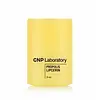What's inside
What's inside
 Key Ingredients
Key Ingredients

 Benefits
Benefits

 Concerns
Concerns

 Ingredients Side-by-side
Ingredients Side-by-side

Triethylhexanoin
MaskingPhytosteryl/Isostearyl/Cetyl/Stearyl/Behenyl Dimer Dilinoleate
Skin ConditioningDiisostearyl Malate
EmollientBis-Diglyceryl Polyacyladipate-2
EmollientDextrin Palmitate
EmulsifyingDipentaerythrityl Hexahydroxystearate/Hexastearate/Hexarosinate
Skin ConditioningGlyceryl Behenate/Eicosadioate
EmollientGlycerin
HumectantWater
Skin ConditioningSilica Dimethyl Silylate
Emollient1,2-Hexanediol
Skin ConditioningSorbitan Stearate
EmulsifyingCedrol
EmollientDimethicone
EmollientParfum
MaskingGluconolactone
Skin ConditioningHelianthus Annuus Seed Oil
EmollientSucralose
Skin ConditioningProtease
ExfoliatingButylene Glycol
HumectantMadecassoside
AntioxidantSerine
MaskingCholesterol
EmollientHydrogenated Lecithin
EmulsifyingBeta-Carotene
Skin ConditioningDaucus Carota Sativa Root Extract
Skin ConditioningDaucus Carota Sativa Seed Oil
EmollientSqualane
EmollientButyrospermum Parkii Butter
Skin ConditioningGlyceryl Glucoside
HumectantAlcohol Denat.
AntimicrobialPropolis Extract
Skin ConditioningCetearyl Alcohol
EmollientTocopherol
AntioxidantStearic Acid
CleansingHoney Extract
HumectantCodonopsis Lanceolata Root Extract
Skin ConditioningFicus Carica Fruit Extract
HumectantMelissa Officinalis Leaf Extract
Skin ConditioningPunica Granatum Fruit Extract
AntioxidantAcetyl Tetrapeptide-9
Skin ConditioningBeta-Glucan
Skin ConditioningCeramide NP
Skin ConditioningCaprylyl Glycol
EmollientCeramide Ns
Skin ConditioningPhytosphingosine
Skin ConditioningAcetyl Hexapeptide-8
HumectantCeramide AP
Skin ConditioningCeramide As
Skin ConditioningDesamido Collagen
Skin ConditioningCeramide EOP
Skin ConditioningCitronellol
PerfumingGeraniol
PerfumingLinalool
PerfumingCitral
PerfumingTriethylhexanoin, Phytosteryl/Isostearyl/Cetyl/Stearyl/Behenyl Dimer Dilinoleate, Diisostearyl Malate, Bis-Diglyceryl Polyacyladipate-2, Dextrin Palmitate, Dipentaerythrityl Hexahydroxystearate/Hexastearate/Hexarosinate, Glyceryl Behenate/Eicosadioate, Glycerin, Water, Silica Dimethyl Silylate, 1,2-Hexanediol, Sorbitan Stearate, Cedrol, Dimethicone, Parfum, Gluconolactone, Helianthus Annuus Seed Oil, Sucralose, Protease, Butylene Glycol, Madecassoside, Serine, Cholesterol, Hydrogenated Lecithin, Beta-Carotene, Daucus Carota Sativa Root Extract, Daucus Carota Sativa Seed Oil, Squalane, Butyrospermum Parkii Butter, Glyceryl Glucoside, Alcohol Denat., Propolis Extract, Cetearyl Alcohol, Tocopherol, Stearic Acid, Honey Extract, Codonopsis Lanceolata Root Extract, Ficus Carica Fruit Extract, Melissa Officinalis Leaf Extract, Punica Granatum Fruit Extract, Acetyl Tetrapeptide-9, Beta-Glucan, Ceramide NP, Caprylyl Glycol, Ceramide Ns, Phytosphingosine, Acetyl Hexapeptide-8, Ceramide AP, Ceramide As, Desamido Collagen, Ceramide EOP, Citronellol, Geraniol, Linalool, Citral
 Reviews
Reviews

Alternatives
Ingredients Explained
These ingredients are found in both products.
Ingredients higher up in an ingredient list are typically present in a larger amount.
Glycerin is already naturally found in your skin. It helps moisturize and protect your skin.
A study from 2016 found glycerin to be more effective as a humectant than AHAs and hyaluronic acid.
As a humectant, it helps the skin stay hydrated by pulling moisture to your skin. The low molecular weight of glycerin allows it to pull moisture into the deeper layers of your skin.
Hydrated skin improves your skin barrier; Your skin barrier helps protect against irritants and bacteria.
Glycerin has also been found to have antimicrobial and antiviral properties. Due to these properties, glycerin is often used in wound and burn treatments.
In cosmetics, glycerin is usually derived from plants such as soybean or palm. However, it can also be sourced from animals, such as tallow or animal fat.
This ingredient is organic, colorless, odorless, and non-toxic.
Glycerin is the name for this ingredient in American English. British English uses Glycerol/Glycerine.
Learn more about GlycerinParfum is a catch-all term for an ingredient or more that is used to give a scent to products.
Also called "fragrance", this ingredient can be a blend of hundreds of chemicals or plant oils. This means every product with "fragrance" or "parfum" in the ingredients list is a different mixture.
For instance, Habanolide is a proprietary trade name for a specific aroma chemical. When used as a fragrance ingredient in cosmetics, most aroma chemicals fall under the broad labeling category of “FRAGRANCE” or “PARFUM” according to EU and US regulations.
The term 'parfum' or 'fragrance' is not regulated in many countries. In many cases, it is up to the brand to define this term.
For instance, many brands choose to label themselves as "fragrance-free" because they are not using synthetic fragrances. However, their products may still contain ingredients such as essential oils that are considered a fragrance by INCI standards.
One example is Calendula flower extract. Calendula is an essential oil that still imparts a scent or 'fragrance'.
Depending on the blend, the ingredients in the mixture can cause allergies and sensitivities on the skin. Some ingredients that are known EU allergens include linalool and citronellol.
Parfum can also be used to mask or cover an unpleasant scent.
The bottom line is: not all fragrances/parfum/ingredients are created equally. If you are worried about fragrances, we recommend taking a closer look at an ingredient. And of course, we always recommend speaking with a professional.
Learn more about ParfumTocopherol (also known as Vitamin E) is a common antioxidant used to help protect the skin from free-radicals and strengthen the skin barrier. It's also fat soluble - this means our skin is great at absorbing it.
Vitamin E also helps keep your natural skin lipids healthy. Your lipid skin barrier naturally consists of lipids, ceramides, and fatty acids. Vitamin E offers extra protection for your skin’s lipid barrier, keeping your skin healthy and nourished.
Another benefit is a bit of UV protection. Vitamin E helps reduce the damage caused by UVB rays. (It should not replace your sunscreen). Combining it with Vitamin C can decrease sunburned cells and hyperpigmentation after UV exposure.
You might have noticed Vitamin E + C often paired together. This is because it is great at stabilizing Vitamin C. Using the two together helps increase the effectiveness of both ingredients.
There are often claims that Vitamin E can reduce/prevent scarring, but these claims haven't been confirmed by scientific research.
Learn more about Tocopherol